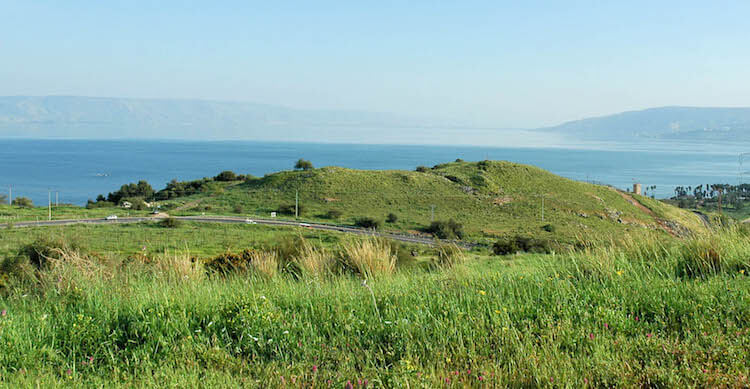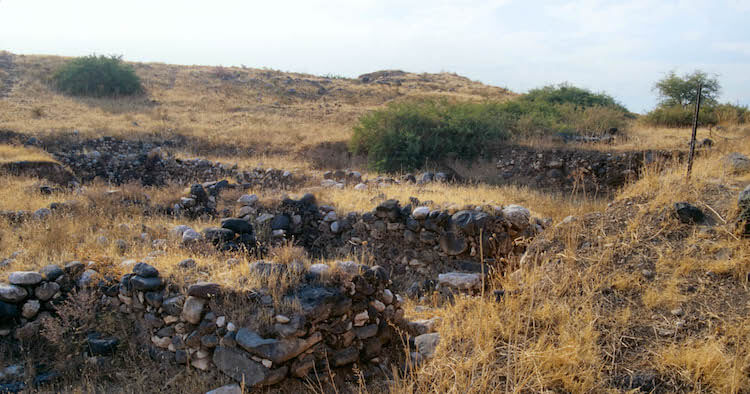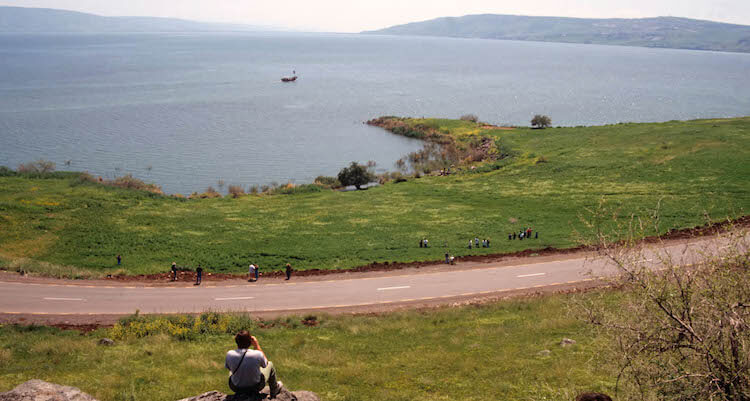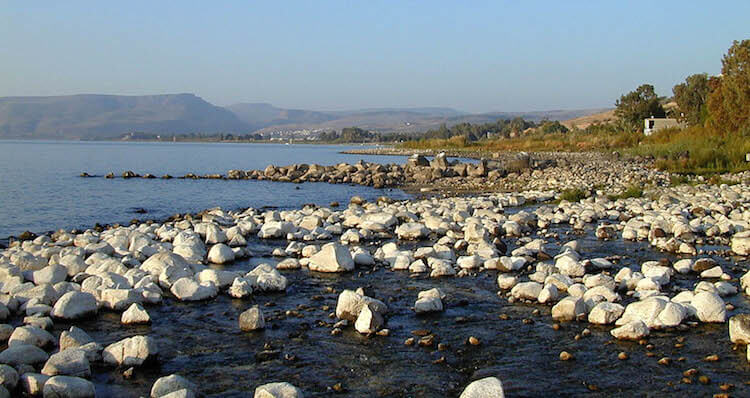The oldest name for the Sea of Galilee is “Chinnereth.” The name means, “harp,” and the lake likely took the name because of the shape of its perimeter.

(Photo: Tel Chinnereth beside the Sea of Galilee. Courtesy of the Pictorial Library of Bible Lands)
Driving around the northern side of Sea of Galilee causes the neck of most folks to turn back and forth a lot. There’s so much to see without ever leaving the vehicle! For example:
- The Mount of Beatitudes tops a conspicuous slope. You can’t miss the chapel on top.
- If Capernaum weren’t obvious because of its road sign, the throng of tour buses turning in would give it away.
- The towering Mount Arbel orients every person to the northwest side of the Sea of Galilee.
But several other sites are less easy to see. That’s because they look like little more than a turn in the road, an inlet in the lake, or a gated-off sidewalk.
All 3 sites are worth tapping the brakes—and even worth the trouble of getting out and enjoying.
Tel Chinnereth
An Old Testament town with the same name as the lake, Chinnereth, sat alongside the sea as well as the ancient International Highway that led to Syria.
- So significant was Chinnereth’s location that it found its way in Pharaoh Thutmose III’s list of conquered cities, along with Laish (Tel Dan), Hazor, and Pella.
- Joshua listed it as one of the fortified cities of the tribe of Naphtali (Joshua 19:35).

(Photo: Tel Chinnereth 9th-century BC gate. Courtesy of the Pictorial Library of Bible Lands)
A few finds at Tel Chinnereth include:
- A 9th-century BC gate
- An Egyptian granite stela dating from the time of the exodus
- A scarab with the name of Tiy, Amenhotep III’s queen
Tel Chinnereth sits inconspicuously beside a turn in the road. If you don’t know to look for it, it’s easy to miss. This Google Street view shows you what it looks like. (Click and drag!)
(Can’t see the panorama in email? Click here.)
Cove of the Sower
On the “same day” Jesus performed a healing in the Capernaum synagogue—where He anticipated the nation rejecting Him—He changed His teaching method to include parables (Matthew 13:1-3).
The location of Jesus’ initial parables—spoken from a boat—likely occurred in a cove of the Sea of Galilee close to Capernaum. In this instance, Scripture, science, and geography converge to point to the “Cove of the Sower” as the probable location for this event.

(Photo: The Cove of the Sower. Courtesy of the Pictorial Library of Bible Lands)
- A study of the natural acoustics at the site revealed that around 14,000 people could fit above the cove on a slope that forms a natural theater and clearly hear a lone voice on the shoreline.
- Best experienced in the morning before traffic begins, visitors can station someone on the shoreline while others scatter on the hillside to listen.
Primacy of Peter Church at Tabgha
A fence and a sign point to the “Primacy of Peter,” and a narrow footpath leads to this modest Franciscan chapel constructed in 1933.
- The site’s Greek name, Heptapegon (Arabic, Tabgha), means “place of seven springs.”
- Five springs still exists and still attract fish today.

(Photo: Tabgha harbor near the Primacy of Peter. Courtesy of the Pictorial Library of Bible Lands)
The sign inside reads “Mensa Christi” and refers to the bedrock “table of Christ” where Jesus served broiled fish for breakfast. The account of the miraculous catch of fish in John 21 likely occurred along this shoreline at the Sea of Galilee. Here Jesus reinstated a guilt-ridden Peter after his threefold denial of Christ.
In this same vicinity three years earlier, Jesus used another miraculous catch to illustrate Peter’s calling:
From now on you will be catching men. —Luke 5:10
The repetition of the miracle after Peter’s failure revealed that Jesus’ calling on the fisherman’s life had not changed.
That speaks to us as well, doesn’t it? Rather than staring over with someone else, God wants to start over with us. He is the God of second chances.
This Google Street View allows you a 360-degree view of the chapel and shoreline. (Click and drag!)
(Can’t see the panorama in email? Click here.)
Tell me what you think: What other sites are easy to miss? To leave a comment, just click here.
Map of Tel Chinnereth, Primacy of Peter Church at Tabgha, and the Cove of the Sower
You’ll find these sites and more in a book I wrote for the Israel Ministry of Tourism, 100 Off-The-Beaten-Path Sites. You can download a free copy.
